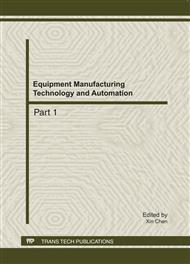p.479
p.484
p.489
p.498
p.503
p.511
p.516
p.523
p.529
An Innovative Design of a Measuring Equipment and Using TiO2 Nanogrease to Reduction of Friction Force for Pneumatic Cylinder
Abstract:
The purpose of the study is to measure the maximum static friction and dynamic friction in the actuation process of pneumatic cylinder after TiO2 nanoparticles are added to grease. The study makes an innovative design of a new measuring equipment of friction force, which can measure the friction force between the piston seal in pneumatic cylinder and the cylinder bore. The friction force of pneumatic cylinder bore directly affects the output dynamic property of pneumatic cylinder motion. Friction force measuring system can measure the change of friction force of pneumatic cylinder bore under the condition with different operating speeds, and can analyze the relationship between friction force of pneumatic cylinder and output dynamic property of pneumatic cylinder. Such a friction force measuring equipment takes pneumatic cylinder as an output of motive force to drive the measurement of pneumatic cylinder, and uses load cell and draw-line encoder to measure the friction force of pneumatic cylinder bore and the motion speed. In the experiment, the friction forces of pneumatic cylinder given with oil and without oil are measured respectively, achieving the friction force property of pneumatic cylinder bore when being lubricated by nanogrease added with nanoparticles of different weight percentages (wt.%). The experimental results show that adding TiO2 nanoparticles to grease can effectively decrease the friction force produced in the actuation process of pneumatic cylinder.
Info:
Periodical:
Pages:
503-510
Citation:
Online since:
August 2011
Authors:
Keywords:
Price:
Сopyright:
© 2011 Trans Tech Publications Ltd. All Rights Reserved
Share:
Citation:


